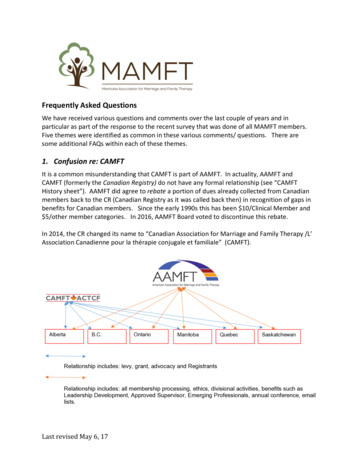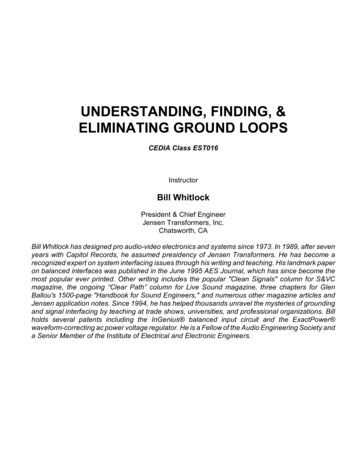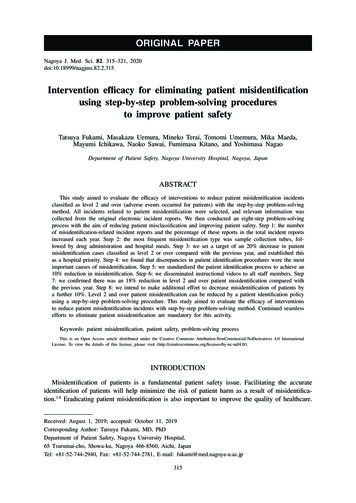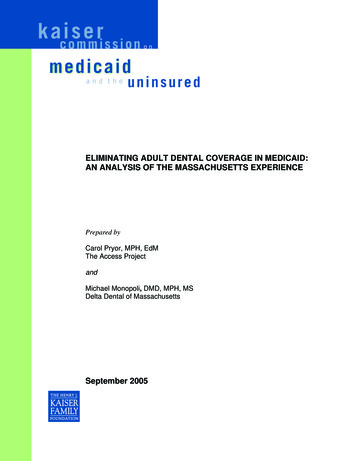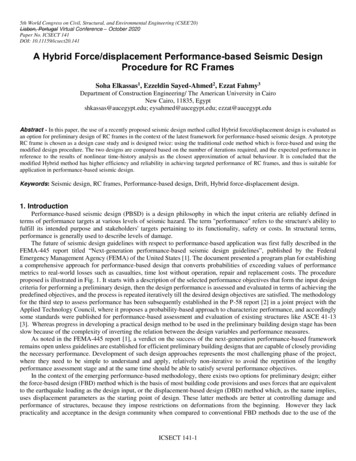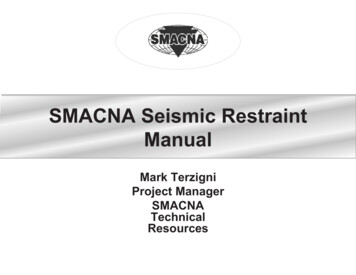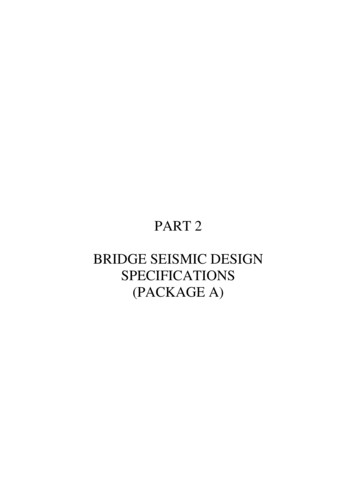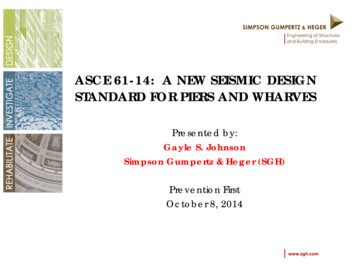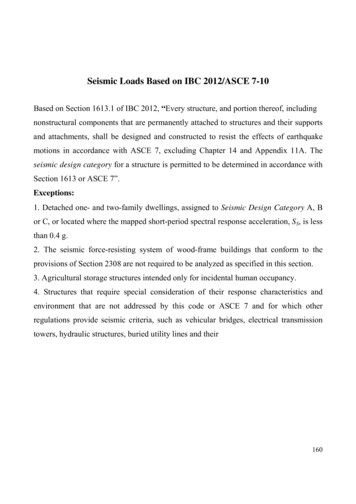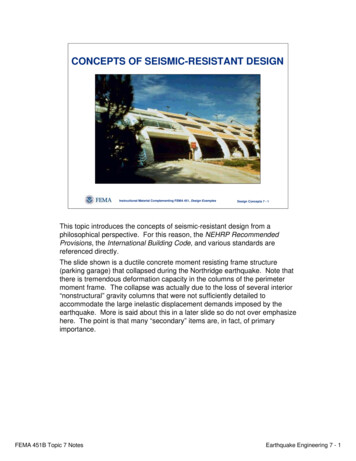
Transcription
Eliminating the Confusion fromSeismic Codes and StandardsPlusDesign and Installation InstructionByOlivier S. BraquetnVent CADDY Director, Global Seismic Business&Daniel C. DuggannVent CADDY Sr. Business Development Manager, SeismicMember ASCE 19 Committee on Structural ApplicationsMember NFPA 13 Committee on Hanging and BracingMember UL 203 STP for Listing of Hangers and Seismic Braces&Daniel J. DuggannVent CADDY Business Development Manager, SeismicMember NFPA 13 Committee on Hanging and Bracing
PART 1Introduction to earthquakesbyOlivier S. BraquetnVent CADDY Director, Global Seismic Business
Brief introduction to Earthquakes Earthquake – Rapid vibration of the earth’s surface due to the sudden movements in thesubsoil, leading to energy release spreading in the shape of waves propagating in alldirections Focus (Hypocenter) – Exact point in the subsoil where a rupture starts and from whichthe energy generated radiates Epicenter – Hypocenter vertical projection onto the surface
Measuring a quake’s intensityMercalli ScaleEstimates intensity on thesurface based on the effectlocally induced on structures,people and things.Richter ScaleMeasures energy released atfocus (logarithmic scale)Peak GroundAccelerationMeasures horizontal waves’maximum acceleration on thesurface in “g” (m/s2)
Most powerful earthquake recordedChile - Valdivia (May 22nd, 1960) 3000 casualties 2.000.0000 evacuated 6.000.000.000 damages (actualized 2011)Details Depth: 39km / 25mi Duration: 6 minutes Mercalli: XI/XII Richter: 9.5 PGA: 0.33g
Seismic Maps
Structure not seismically engineered7
Operating system not protected8
Structural and non-structural seismicprotection3. SEISMIC STRUCTURE & BRACING: THE BUILDING & THE SERVICES MAINTAIN THEIR FUNCTIONALITY AND OPERABILITY9
How damage occursSwayingColliding
Brace to protect11
How damage occursOverturningSliding
Anchor to protect
Buildings that require seismic choolsPrisonsCasinosPowerWater TreatmentPharmaceutical
Part 2Eliminating the Confusionfrom Seismic Codes & StandardsbyDaniel C. DuggannVent CADDY Sr. Business Development Manager, SeismicMember ASCE 19 Committee on Structural ApplicationsMember NFPA 13 Committee on Hanging and BracingMember UL 203 STP for Listing of Hangers and Seismic Braces
History 1977 Earthquake Hazards Reduction Act (Public law 95-124) NEHRP Standards (National Earthquake Hazards Reduction Program) No requirement for implementing NEHRP Standards 1990 Public Law 101-614 amendments to 95-124 E.O. (Executive Order) 12699 is signed to implement the law FEMA in charge of implementing NEHRP Standards Recommended Seismic Provisions for New Buildings and Other Structures. New construction started after January 4,1993 Federally owned, regulated or funded by Federal loans, grants or loan guarantees Building Seismic Safety Council Certifies Model Building Codes for NEHRP compliance ICBO UBC Uniform Building Code BOCA National Building Code SBCCI Standard Building Code
History Cont’d 1996 UBC, BOCA & SBCCI Agree not to publish further updates to their Codes Agree to promulgate the use of the IBC (International Building Code) when published 1997 UBC publishes a 1997 Edition of its Building Code 2000 ICC (International Code Conference) published its 1st Edition of the IBC BSSC certified the 2000 IBC to satisfy NEHRP and the Federal Law
History Cont’d 2003 ICC (International Code Conference) published the 2003 IBC BSSC certified the 2003 IBC to satisfy NEHRP and the Federal Law 2003 IBC also generally references ASCE 7-02 Minimum Design Loads forBuildings for seismic protection 2006 ICC (International Code Conference) published the 2006 IBC BSSC certified the 2006 IBC to satisfy NEHRP and the Federal Law 2006 IBC specifically references ASCE 7-05 for seismic protection ASCE 7-05 Chapter 13 Seismic Design Requirements for Nonstructural Components
History Cont’d 2009 ICC published the 2009 IBC BSSC certified the 2009 IBC to satisfy NEHRP and the Federal Law 2009 IBC specifically references ASCE 7-05 for seismic protection ASCE 7-05 Chapter 13 Seismic Design Requirements for Nonstructural Components 2012 ICC (International Code Conference) published the 2012 IBC BSSC certified the 2012 IBC to satisfy NEHRP and the Federal Law 2012 IBC specifically references ASCE 7-10 for seismic protection ASCE 7-10 Chapter 13 Seismic Design Requirements for Nonstructural Components
History Cont’d 2015 ICC published the 2015 IBC BSSC certified the 2015 IBC to satisfy NEHRP and the Federal Law 2015 IBC specifically references ASCE 7-10 for seismic protection ASCE 7-10 Chapter 13 Seismic Design Requirements for Nonstructural Components 2016 E.O. (Executive Order) 13717 Cancels and replaces E.O. 12699 NIST (National Institute of Science and Technology) replaced FEMA as lead agency ICSSC (Interagency Committee on Seismic Safety in Construction) replaced BSSC forimplementation of NEHRP Requires compliance with 2015 IBC or later seismic provisions
History Cont’d 2018 ICC published the 2018 IBC ICSSC certified the 2018 IBC to satisfy NEHRP and theFederal Law 2018 IBC specifically references ASCE 7-16 for seismicprotection ASCE 7-16 Chapter 13 Seismic Design Requirements forNonstructural Components
Federal Documents NEHRP specifically references Seismic Provisions of ASCE 7 ALL Federal Agencies are required to comply with NEHRP CEGS (Corps of Engineers Guide Spec) NAV-FAC (Naval Facilities Engineering Command) UFGS (Unified Facilities Guide Specifications ALL reference ASCE 7 Chapter 13 Seismic DesignRequirements for Nonstructural Components
CBC / OSHPD CBC (California Building Code) is the IBC OSHPD Code is the CBC with further restrictions / exceptions OSHPD Code is for California owned and regulated hospital facilitiesExceptions to the CBC are published “Express Terms”Code Application Notices (CANs) to interpret specific sections of the CBCPolicy Intent Notice (PIN) is the OSHPD policy on a specific subjectASCE 7-16 Chapter 13 Seismic Design Requirements for NonstructuralComponents
ASCE 7 Chapter 13 Chapter 13 of ASCE 7-10 appears in pages 111-125 Section 13.2 General Design Requirements Section 13.2.2 Special Certification Requirements for DesignatedSeismic Systems Certain Active Mechanical & Electrical equipment Section 13.2.5 Testing Alternative for Seismic Capacity Determination References ICC-ES (International Code Conference Evaluation Service) AC 156shake table testing While possibly desirable for marketing, NEBS Level 3 Zone 4 ComplianceTesting per Telcordia Technologies GR-63 CORE is not recognized by the ICC orASCE 7
ASCE 7 Chapter 13 Cont’d. Section 13.5.7 Access Floors Section 13.6.4 Electrical Components Section 13.6.5.6 Conduit, Cable Tray, and Other ElectricalDistribution Systems (Raceways) Section 13.6.11 Other Mechanical and Electrical Components Section 13.1.4 EXEMPTIONS
Moral of the Story Get the ASCE 7 edition referenced by the applicable Code Read Chapter 13. Mystery Solved!
PART 3Overview of theInternational legal and code landscapebyOlivier S. BraquetnVent CADDY Director, Global Seismic Business
Examples of standards Internationally Used ISO/IEC 11801, Generic Cabling for Customer Premises ISO/IEC 18010:2002, Pathways and Spaces ISO/IEC 24764, Generic Cabling Systems for Data Centres ISO/IEC 14763-2: 2012, Information technology – Implementation and operation of customerpremises cabling – Part 2: Planning and installation ANSI/TIA-568-C.0, Generic Telecommunications Cabling for Customer Premises ANSI/TIA-606-A, Administration Standard for the Telecommunications Infrastructure ofCommercial Buildings ANSI/TIA-942, Telecommunications Infrastructure Standard for Data Centres IEEE 802.3af, Power over Ethernet (PoE) Standard.
Example of standard language ISO/IEC 14763-2 (2012), Information technology – Implementation andoperation of customer premises cabling – Part 2: Planning and installation Section 5.3.5. Environmental conditions Section 5.3.5.1 Requirements the following environmental considerations shall be taken into consideration:impact of natural events e.g. lightning strike, earthquake
Examples of regionally used standards Cont’d. EU– EN 50173, Information Technology – General Cabling Systems– EN 50173 Part 2, Installation Planning and Practices Inside Buildings Australia / – AS/NZS 3080:2013, Information technology – Generic cabling forcustomer premisesNewZealand – AS/NZS 3084:2003(R2013), Telecommunications installations Telecommunications pathways and spaces for commercial buildings– EIA/TIA 568 & 569, Generic Telecommunications Cabling forCustomer Premises & Pathways and Spaces China– GB 50174:2017 Code for design of electronic information systemrooms and data centersNo guidance
Moral of the International Landscape No international legal or code document provide enough guidance, Most national laws guide designers towards using regionally recognized codesand standards when the national level is not enough, and using internationalcodes and standards when the regional level is in turn not enough,So, since outside of the U.S. laws and codes do not specify what to do and how todo it: Get the latest edition of ASCE 7 Read Chapter 13. Problem Solved!
Q&A
BREAK5 Minutes
PART 4Seismic Design & InstallationbyDaniel J. DuggannVent CADDY Business Development Manager, SeismicMember NFPA 13 Committee on Hanging and Bracing
Building CodeASCE 7-10 or 7-16Why do we need to braceo Required by the building codeo Protects propertyo Protects critical/mission critical systemso Most Importantly, protects People
Seismic Design Category C, D, E, or FSeismic DesignCategory (SDC)Importance FactorIp 1.0Ip 1.5 (Life Safety orHazardous)AEXEMPT – Seismic NotRequiredEXEMPT – Seismic NotRequiredBEXEMPT – Seismic NotRequiredEXEMPT – Seismic NotRequiredCEXEMPT – Seismic REDFREQUIREDREQUIRED
Single Hanger Conduit Exemptions ASCE 7-10
Suspended Trapeze, Cable Tray, LadderTray, Basket Tray ExemptionsASCE 7-10Tray weightper Ft.SDC CSDC D, E or FIp 1.0Ip 1.5Ip 1.0Ip 1.5 5 Lbs/FtExemptREQUIREDREQUIREDREQUIRED 10 Lbs/FtExemptREQUIREDREQUIREDREQUIRED
Suspended Equipment Exemptions ASCE7-10
Cable trayWire basketLadder
Racks & cabinetsRaised floor installationConcrete
Non-continuous supports(J-Hooks for example)Various types of installation – wall mount, suspended via wire,threaded rod, etc.
media installed by the LVindustryCameraWAP’s –Wireless Access PointsSpeakers – Can vary greatly in weightProjectors
Data Centers
Zone distribution cabinets
Earthquake Damage
Codes & Standardsenterprise & OSP (Outside Plant Cabling)
Where seismic bracing may beenforced more strictlyMission Critical Data CentersGovernment buildings and other criticalpotential bomb/explosion (ATFP issues)buildings/structuresHospitalsK-12 and other education facilities
Q&A
BREAK5 Minutes
Part 5Seismic DesignbyDaniel C. DuggannVent CADDY Sr. Business Development Manager, SeismicMember ASCE 19 Committee on Structural ApplicationsMember NFPA 13 Committee on Hanging and BracingMember UL 203 STP for Listing of Hangers and Seismic Braces
Primary Seismic Design RequirementsofASCE 7-16All nonstructural components Braced to resist seismic force 360 horizontally Horizontal Seismic Force Fp Consideration of vertical loads & reactions Upward (rod stiffeners) Downward Some components are exempted Seismic Design Category (SDC)Component Importance Factor (IP)Component SizeMethod of Attachment
Seismic Brace Orientation Transverse Brace Perpendicular to run Longitudinal Brace Parallel to run 4-way Brace Transverse & Longitudinal at same point
Seismic Brace Locations Horizontal Runs of Conduit, Trapeze Supported Equipment, CableTrays, etc. Changes of Direction
Seismic Brace Spacing 40 ft. Max. Transverse Spacing 80 ft. Max. Longitudinal Spacing 40 ft. Max. 4-way Spacing Achievable spacing limited by brace assembly strength
Types of Bracing Tension/Compression Bracing Pipe, Angle Iron & Strut Resists loads ½ in tension – ½ in compression Length limited by K1/r 200 Brace element on one side of braced component
Types of Bracing Tension Only Bracing Aircraft Cable Resists loads in tension 100% of the time Unlimited length – NO Kl/r limitation Brace element on both sides of braced component
Horizontal Seismic ForceTEXT
Horizontal Seismic Force cont’d.TEXT
TEXT
TEXT
TEXT
IBC Seismic Activity MapsASCE 7 0.2 sec Spectral Response Acceleration Map Used to determine HLF Also used in determining bracing exemption 1 sec Spectral Response Acceleration Map Used in determining bracing exemption
TEXT
TEXT
Critical Brace Strength Points
Concrete Anchors (Prying)
Concrete Anchors ASCE 7 Requires Anchor Calculations In accordance with ACI 318 ACI 355.2 Seismic Simulation Testing Determination of forces to take into account effectsof prying and eccentricities Consideration of Overstrength Ω0 Maximum Ω0 2.0
Vertical Seismic ForceTEXT
Upward resultant vertical force Same reaction for BOTH brace types Rod stiffeners requiredWHENANDthere is net upward resultantKl/r is less than 200
Upward Vertical Force ( Ev ) Upward Vertical forces: Vertical Reaction Horizontal Force divided by TangentBrace Angle from Vertical minus 0.6 D in some cases ASCE 7 additional vertical force 0.2SDSD
Downward resultant vertical force ONLY for Tension/Compression Braces Occurs when braces resist loads in compression
Downward Vertical Force ( Ev ) Downward Vertical forces: Downward Vertical Reaction Hori
Building Code ASCE 7-10 or 7-16 o Required by the building code o Protects property o Protects critical/mission critical systems o Most Importantly, protects People Why do we need to brace. Seismic Design Category C, D, E, or F Seismic Design Category (SDC) Importance Factor I p 1.0 I 1.5 (Life Safety or Hazardous) A EXEMPT – Seismic Not Required EXEMPT – Seismic Not Required B
